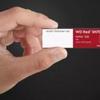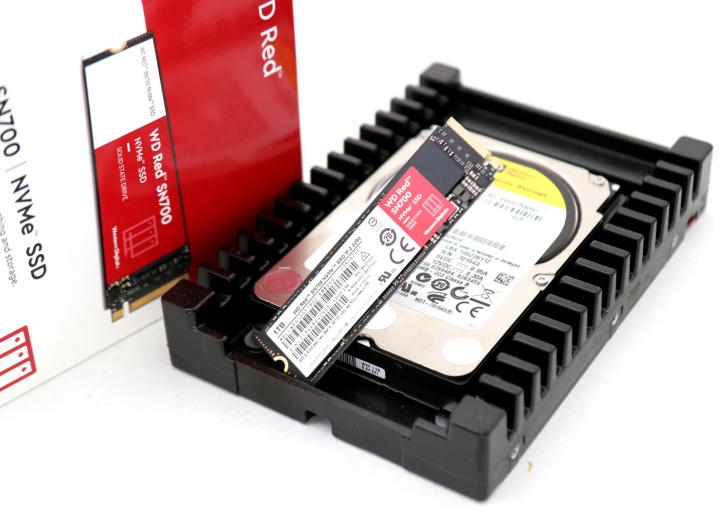Final Words & Conclusion
Final Words & Conclusion
As prices come down and performance goes up we already mentioned several times that NAND flash for NAS units are gaining popularity. The easy way would be using the NVMe SSD as a cache unit, in the long run when pricing comes down under 10 Cents per GB, we foresee NAND-based cold storage to be the better option. For both use cases, you'll want reliable storage with plenty of endurance (however for cold storage that's less of an issue). BTW cold storage is for example a big video file that resides on your NAS for two years. Hot storage would be a cache, continuously seeing white actions in OS and database-like workloads. The WD RED SN700 offers the endurance you'll want for hot storage, with a rated 2000 TBW for the 1TB model. Next to that when you factor in the performance of a NAS unit at the fastest available 10 Gbit jack, you'd max out at 1250 MB/sec. So this NVMe unit is plenty fast for its assigned workload. Linear and sustained performance show good PCIe 3.0 numbers, albeit in the frame capture test we did stumble into a TLC bottleneck. But even then we're looking at roughly 1500 MB/sec on writes which is plenty fast for any NAS. Therefore the WD Red SN700 SSD has a lot to offer in terms of performance and reliability. As a starting point, this is clearly one of the highest endurance SSDs available in their current home/SMB lineup of drives, with 0.7 to 1 DWPD (capacity dependent) endurance, and if you are looking for an SSD to use as a write-enabled cache (or Read/Write) for your say Synology or ASUSTOR NAS system, you will definitely feel better about the lifespan provided as that is exactly the workload that is more demanding on writes.
Endurance
We've talked about endurance previously; it's the number of times NAND cells can be written before they begin to malfunction. It is sufficient to remark that the values for QLC written (4 bits saved in a single NAND cell) are not particularly good at it. On this point, however, I always like to paraphrase Einstein: "Relativity, my man," he said. You can improve endurance by increasing the volume of your training sessions. 98 percent of your data is stored in a 'cold' state on your SSD and does nothing, and it is only the 2 percent of data that is written that is important. Volume sizes that are larger result in more NAND cells, and more NAND cells result in greater endurance. The SN700 however uses TLC written NAND and our 1TB model has a rating of 2000 TB written capacity, the 2TB model has a proper 2500 TB written capacity for endurance, and the 4 TB model is a gnarly 5100 TBW (4TB). As a result, our tested 1 TB SSD generates 2000TB with a 1DWPD rating, that's the full SSD written each day for its guaranteed 5 years. Now, if a NAND cell fails, it does not necessarily indicate that your data is lost. Many algorithms are constantly monitoring and managing your data; for example, if a cell's lifetime is about to expire, the bits inside that cell will be relocated to a more healthy cell. Let's droP NAS for a second; so how long does a 2000 TWB storage unit last before NAND flash cells go the way of the dodo in your PC then? Well, if you are a really extreme user, you might be writing 50 GB per day (really normal users probably won't even write that per week), but based on that value, 50GB x 365days= 18.25 TB per year written. You get 2000 TBW, so that's almost 110 years of usage for the 1TB SSD version. Let me make it very clear, 50 GB per day each day of the year is a very ambitious number on a PC, but far bigger as cache SSD in a SOHO NAS.
Concluding
Western Digital has entered this market with a broad range of capacities to complement the varying degrees of the storage potential in the average user (for NASes with PCIe/M.2 expandability available by default), starting with capacities as low as 250GB and going all the way up to 4TB on that petite little M.2. A NAS is all about your data being kept safe, endurance and performance. Remember though, your NAS needs to be NVMe compatible with at least one slot. Once that qualification is met the RED SN700 does tick all the right boxes. If placed inside a NAS or server the 2000 TBW for the 1TB model rating is really what it's all about. I'd drop this unit into a server without any hesitation. The performance is super fast for the workload, IOPS are plenty fast, sustained is fast and linear it manages well I both reads and writes also. Red receives a boost in performance by switching to the NVMe protocol, which offers both excellent sequential and random performance, thanks to trickle-down technology from the consumer side of the equation.
Perhaps one way of looking at this product is as an improved version of the Black SN750 series with significantly greater endurance. in this respect the WD Red SNH700 has a lot going for it. In addition to its NAS classification, its large storage capacity of up to 4TB, great performance, and extended warranty of five years make it an excellent choice, also for a high-end PC or mainstream workstation. One remark, thermal imaging shows the NAND and controller running hot, please do place it under a heatsink. The other remark of course is pricing, as WD charges a significant premium for this NAS series - the 1TB unit is approximately 30% more expensive than the normal SN750 -, as, with most things in life, you get what you pay for and if endurance is what you're seeking then the SN700 series might be worth it as NAS cache SSD or even an enthusiast PC with high workloads where endurance matters. However, in the last segment PCIe, gen 4.0 is gaining more popularity.
But if we bring it all back to a NAS with 10 Gigsbit/s (maxes at 1250 MB/sec), this of course is plenty fast with massively increased endurance. The SN700 might just be worth the price premium.
Recommended Downloads
- Sign up to receive a notification when we publish a new article
- Or go back to Guru3D's front page



